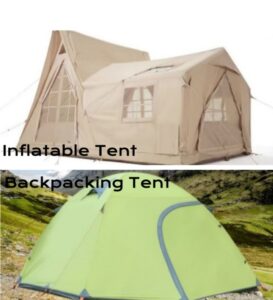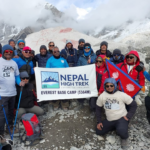Camping is a beloved outdoor activity, and choosing the right tent is critical to ensuring a comfortable and enjoyable experience. Among the various types of tents available, inflatable tents and backpacking tents serve distinct purposes. Both have unique designs, features, and advantages, making them suitable for different kinds of camping adventures. This article explores the key differences between inflatable tents and backpacking tents to help you make an informed choice.
1. Setup and Structure
- Inflatable Tent:
- Design: Inflatable tents, also known as air tents, use air-filled beams instead of traditional metal or fiberglass poles. These tents require an air pump to inflate the beams, which serve as the frame.
- Setup Time: Inflatable tents are known for their quick and easy setup. Once the air pump is attached, the tent can be fully inflated in just a few minutes, and no complex assembly is required. This makes them ideal for campers who prefer minimal hassle when pitching their shelter.
- Ease of Use: The lack of poles simplifies the setup process, making inflatable tents a popular choice for families and casual campers.
- Backpacking Tent:
- Design: Backpacking tents are designed to be lightweight and compact, often using aluminum or fiberglass poles to provide structural support. They prioritize portability and efficiency over space or luxury.
- Setup Time: Backpacking tents usually take longer to set up compared to inflatable tents, as they require assembling poles and securing the tent with stakes and guylines. While not complicated, it may require some practice, especially for first-time users.
- Ease of Use: Although the setup may take more effort, backpacking tents are highly efficient for seasoned hikers and campers, offering a secure and sturdy shelter even in challenging terrains.
2. Weight and Portability
- Inflatable Tent:
- Weight: Inflatable tents tend to be heavier due to the materials used for the air beams and the inclusion of an air pump. They are not designed for long hikes or treks, as their weight and bulk make them less portable.
- Portability: Because inflatable tents are typically larger and bulkier when packed, they are better suited for car camping or situations where transportation is not an issue. They are ideal for families or groups who prioritize space and comfort over carrying ease.
- Backpacking Tent:
- Weight: Backpacking tents are specifically designed to be as lightweight as possible. Materials like lightweight nylon, polyester, and aluminum poles help reduce weight, often resulting in tents that weigh less than 2-3 kg.
- Portability: These tents are compact and easy to pack, making them perfect for long hikes or multi-day backpacking trips. They are designed to be carried in a backpack, making them the go-to choice for adventurers who prioritize portability over comfort.
3. Durability and Weather Resistance
- Inflatable Tent:
- Durability: Inflatable tents are generally made with heavy-duty materials that can withstand various weather conditions. However, the inflatable air beams, while sturdy, may be vulnerable to punctures, which can be a concern in rugged environments.
- Weather Resistance: These tents often have good weatherproofing features, such as water-resistant fabrics and high wind resistance. The air beams are flexible, allowing them to bend in strong winds rather than break, as traditional poles might.
- Backpacking Tent:
- Durability: Backpacking tents are built to endure rough conditions while being lightweight. The poles are designed to be durable, though extreme wind or rough handling can cause damage.
- Weather Resistance: Backpacking tents are highly weather-resistant, with features like double walls, water-resistant coatings, and robust guylines to handle wind, rain, and even snow. Their low profile helps reduce wind exposure, making them ideal for high-altitude or extreme-weather camping.
4. Comfort and Space
- Inflatable Tent:
- Comfort: Inflatable tents generally offer more interior space and higher ceilings, providing a more comfortable and spacious experience. Many inflatable tents come with separate rooms, vestibules, and ample headroom, making them ideal for family camping or longer stays.
- Space: These tents can accommodate larger groups and additional gear. Some models can comfortably fit up to 8-10 people, providing plenty of room to move around.
- Backpacking Tent:
- Comfort: Backpacking tents prioritize function over comfort. They are compact and efficient, often designed to house 1-4 people in a snug, cozy setting. There is usually limited headroom and space, focusing on sheltering campers rather than providing extensive living space.
- Space: Backpacking tents are compact, with enough room to sleep and store basic gear. They are not intended for standing or moving around freely, as their primary goal is to minimize weight and maximize efficiency.
5. Best Use Scenarios
- Inflatable Tent:
- Best For: Inflatable tents are best suited for family camping trips, festivals, or car camping where ease of setup, space, and comfort are prioritized. They are not ideal for remote or rugged locations where portability and weight are crucial factors.
- Backpacking Tent:
- Best For: Backpacking tents are perfect for hiking, trekking, and multi-day camping adventures where every gram of weight counts. They are designed for campers who need a lightweight, durable shelter that can withstand different weather conditions.
6. Cost
- Inflatable Tent:
- Cost: Inflatable tents are generally more expensive due to their specialized materials and design features. The cost reflects their comfort, size, and ease of use.
- Backpacking Tent:
- Cost: Backpacking tents come in a range of prices, with more affordable options available. However, high-end models with advanced weather resistance and ultralight materials can be pricey. These tents offer a balance between cost and performance.
Conclusion
The choice between an inflatable tent and a backpacking tent largely depends on the type of camping you plan to do. If you prioritize comfort, ease of setup, and space and don’t mind the extra weight, an inflatable tent is an excellent choice for car camping or family trips. On the other hand, if you’re embarking on a multi-day hike or need a lightweight, portable shelter, a backpacking tent is the superior option, offering the durability and portability essential for outdoor adventurers.
KASSICO is a professional outdoor camping gear manufacturer in China with more than 10 years of experience, We specialize in high-end camping tents, glamping tents, car tents, sleeping gear, and other camping gear. We have cooperated with more than 300+ customers in EUROPE, the USA, AUSTRALIA, JAPAN, KOREA, etc. Our factory has passed BSCI & ISO9001. We have a strong design team, you can send us your design, we can customize your style, and OEM service is offered based on the customer’s original sample or specification sheet. All the products must be through our QC strict inspection. Quality control is a process through which a business seeks to ensure that product quality is maintained or improved with either reduced or zero errors.








